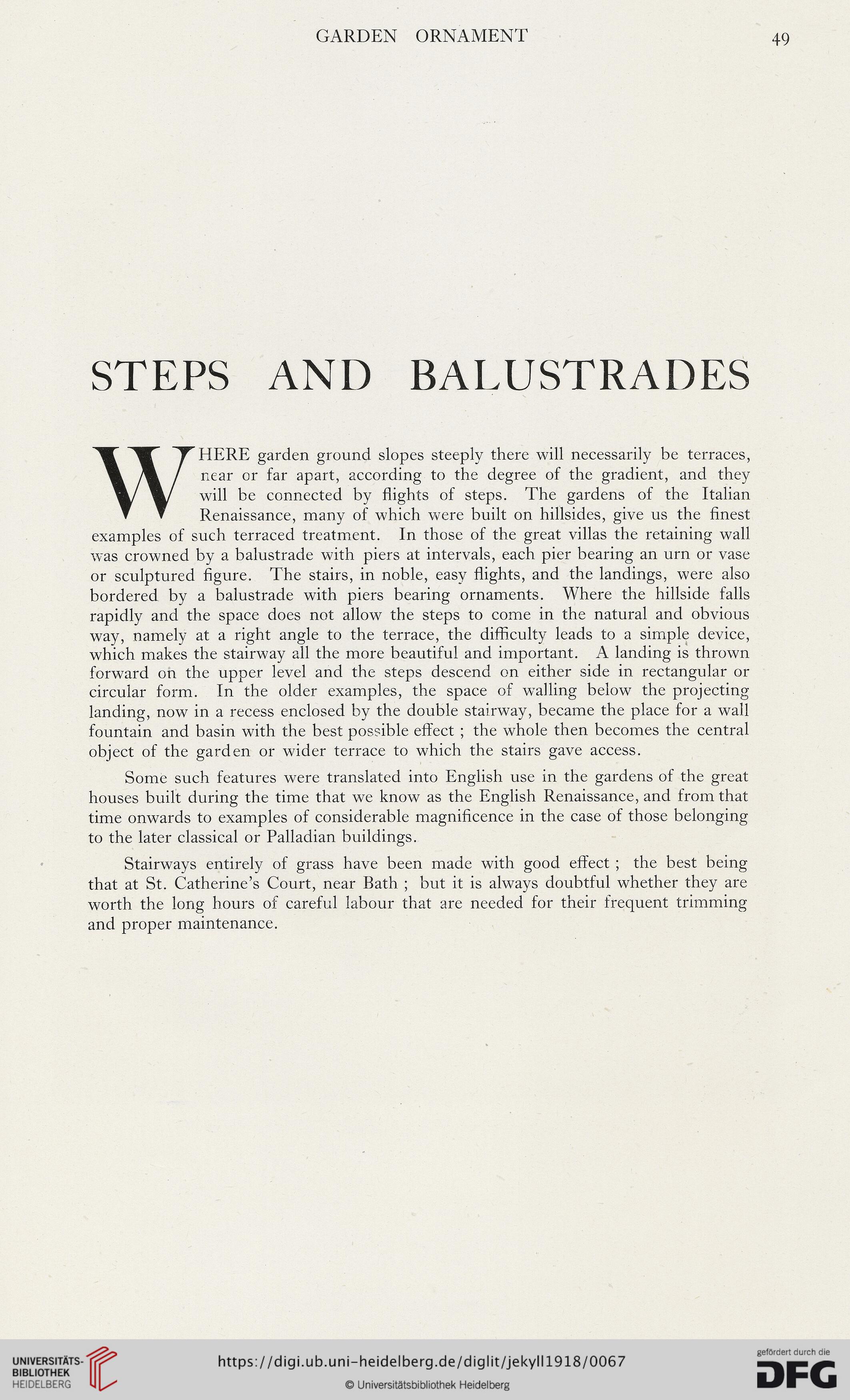GARDEN ORNAMENT
49
STEPS AND BALUSTRADES
HERE garden ground slopes steeply there will necessarily be terraces,
near or far apart, according to the degree of the gradient, and they
will be connected by flights of steps. The gardens of the Italian
Renaissance, many of which were built on hillsides, give us the finest
examples of such terraced treatment. In those of the great villas the retaining wall
was crowned by a balustrade with piers at intervals, each pier bearing an urn or vase
or sculptured figure. The stairs, in noble, easy flights, and the landings, were also
bordered by a balustrade with piers bearing ornaments. Where the hillside falls
rapidly and the space does not allow the steps to come in the natural and obvious
way, namely at a right angle to the terrace, the difficulty leads to a simple device,
which makes the stairway all the more beautisul and important. A landing is thrown
forward on the upper level and the steps descend on either side in rectangular or
circular form. In the older examples, the space of willing below the projecting
landing, now in a recess enclosed by the double stairway, became the place for a wall
fountain and basin with the best possible effect ; the whole then becomes the central
object of the garden or wider terrace to which the stairs gave access.
Some such features were translated into English use in the gardens of the great
houses built during the time that we know as the English Renaissance, and from that
time onwards to examples of considerable magnificence in the case of those belonging
to the later classical or Palladian buildings.
Stairways entirely of grass have been made with good effect ; the best being
that at St. Catherine’s Court, near Bath ; but it is always doubtful whether they are
worth the long hours os careful labour that are needed for their frequent trimming
and proper maintenance.
49
STEPS AND BALUSTRADES
HERE garden ground slopes steeply there will necessarily be terraces,
near or far apart, according to the degree of the gradient, and they
will be connected by flights of steps. The gardens of the Italian
Renaissance, many of which were built on hillsides, give us the finest
examples of such terraced treatment. In those of the great villas the retaining wall
was crowned by a balustrade with piers at intervals, each pier bearing an urn or vase
or sculptured figure. The stairs, in noble, easy flights, and the landings, were also
bordered by a balustrade with piers bearing ornaments. Where the hillside falls
rapidly and the space does not allow the steps to come in the natural and obvious
way, namely at a right angle to the terrace, the difficulty leads to a simple device,
which makes the stairway all the more beautisul and important. A landing is thrown
forward on the upper level and the steps descend on either side in rectangular or
circular form. In the older examples, the space of willing below the projecting
landing, now in a recess enclosed by the double stairway, became the place for a wall
fountain and basin with the best possible effect ; the whole then becomes the central
object of the garden or wider terrace to which the stairs gave access.
Some such features were translated into English use in the gardens of the great
houses built during the time that we know as the English Renaissance, and from that
time onwards to examples of considerable magnificence in the case of those belonging
to the later classical or Palladian buildings.
Stairways entirely of grass have been made with good effect ; the best being
that at St. Catherine’s Court, near Bath ; but it is always doubtful whether they are
worth the long hours os careful labour that are needed for their frequent trimming
and proper maintenance.




